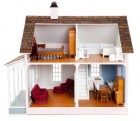(Time to read: ~3 minutes)
People who do mental and paper-work where they have ready access to the following 3 types of spaces tend to stay more on top of their work with less effort.
If any one of these are missing, it is extremely difficult to stay clear and organized.
1) Working Space
Research indicates that, as a primary working area for even moderately complex tasks, people benefit from a working surface of at least 30″ x 60″. Interestingly enough, this is the same size as an average dining room table.
Have you noticed, as I have, that friends, colleagues, and clients often clear off the dining room table to work on tasks like sorting documents at tax time? We are all wiser than we realize! 🙂
2) “Holding” Space
Every day, documents and other “things” arrive in our working areas at times we are not prepared to work on them. Or we are in the middle of working on something when we are interrupted to deal with something else – and then interrupted again to work on a 3rd or 4th thing.
We need a place to be able to “hold” the things we are not finished with. And I’ve discovered that it works better to “hold” these things:
- Somewhere other than on on our desks (working space). Because that tends to get quickly cluttered with many projects that severely limit the working space, and make it much more difficult to disentangle the different threads later.
. - On a flat surface, rather than in a file. Because it’s harder to remember what’s in a file, and files are easier to ignore (because they look relatively neat). The two kinds of “holding” spaces that work well are 1) separate tables or credenzas, or 2) open shelves. I’ve found that the surface area of the holding space needs to be 1-2 times the size of the working area.
. - In an area that’s within arm’s reach of the working surface but out of sight when we’re working (for example, behind us).
We also need to mentally reserve these as temporary holding spaces, and need to have a regular process for ensuring the items get actioned and the “holding” area cleared on a regular basis.
3) Storage Space
Once we’ve finished working on something for now, there needs to be a place – other than our desks or “holding” spaces – for the task or project notes and materials to be stored. Often this is some kind of filing system.
Without this third kind of space, our desks and “holding” areas (if we have them) get “gummed up” with completed projects. This makes it harder for us to stay clear (e.g., about what we need to be working on) and focused (on the task we’ve chosen for now).
Also, this space needs to be REALLY easy to access – ideally as easy as our holding area – so there’s no barrier to our putting away things we’re finished with for now. And thus no temptation to leave them in our working or holding areas.
How does your office measure up?
Do you have all 3 of these kinds of spaces in your office / working area?
Is the size of each kind of space adequate for your needs?
Are they located in a way that supports you?
Works Even in Cubicles
Think this is impossible because you work in a cubicle? I first consciously implemented this principle when I was working in a cubicle that was the length of my desk and one chair, and as wide as my desk, chair, and a cubicle doorway.
So… What would be the quickest and easiest way you could get the space(s) you need to be more effective with less effort?
* * * * *
Would you like support to lay out your working space for greater ease and effectiveness? Perhaps I can help.
You can book a short initial free session to discuss what you are looking for and what I offer, to see if there’s a fit.
Or if you are keen to get results, you can jump right in and book a working session. If you are not satisfied at the end of the session, there’s no fee.
(Note: I do most work over the phone or internet. People are often initially surprised and skeptical that this kind of “distance” support can be effective – then pleasantly surprised and amazed at how effective it actually is! Also delighted at the cost-effectiveness – if they only need 15 minutes of support to figure out how to solve a problem, that’s all they pay for.)
Wishing you joy, ease and satisfaction in your work!
Warmly,
🙂
Glenda


Comments are closed.